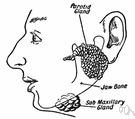adenosis
Also found in: Thesaurus, Medical, Encyclopedia.
Related to adenosis: sclerosing adenosis, microglandular adenosis
ad·e·no·sis
(ăd′n-ō′sĭs)n. pl. ad·e·no·ses (-sēz′)
A disease of a gland, especially one marked by the abnormal formation or enlargement of glandular tissue.
American Heritage® Dictionary of the English Language, Fifth Edition. Copyright © 2016 by Houghton Mifflin Harcourt Publishing Company. Published by Houghton Mifflin Harcourt Publishing Company. All rights reserved.
adenosis
(ˌædɪˈnəʊsɪs)n
a minor glandular condition typified by swelling of the lymph glands
Collins English Dictionary – Complete and Unabridged, 12th Edition 2014 © HarperCollins Publishers 1991, 1994, 1998, 2000, 2003, 2006, 2007, 2009, 2011, 2014
ThesaurusAntonymsRelated WordsSynonymsLegend:
Switch to new thesaurus
| Noun | 1. |  adenosis - a disorder of the glands of the body adenosis - a disorder of the glands of the bodydisorder, upset - a physical condition in which there is a disturbance of normal functioning; "the doctor prescribed some medicine for the disorder"; "everyone gets stomach upsets from time to time" hyperparathyroidism - excessive secretion of parathyroid hormone resulting in abnormally high levels of calcium in the blood; can affect many systems of the body (especially causing bone resorption and osteoporosis) hypoparathyroidism - inadequate secretion of parathyroid hormone resulting in abnormally low levels of calcium in the blood hyperpituitarism - excessive activity of the pituitary gland (especially overactivity of the anterior lobe which leads to excess secretion of growth hormone) Addison's disease, Addison's syndrome, hypoadrenalism, hypoadrenocorticism - a glandular disorder caused by failure of function of the cortex of the adrenal gland and marked by anemia and prostration with brownish skin adenopathy - a glandular disease or enlargement of glandular tissue (especially of the lymph glands) aldosteronism, hyperaldosteronism - a condition caused by overproduction of aldosterone Cushing's disease, hyperadrenalism - a glandular disorder caused by excessive ACTH resulting in greater than normal functioning of the adrenal gland; characterized by obesity Cushing's syndrome, hyperadrenocorticism - a glandular disorder caused by excessive cortisol hyperthyroidism, thyrotoxicosis - an overactive thyroid gland; pathologically excessive production of thyroid hormones or the condition resulting from excessive production of thyroid hormones hypothyroidism - an underactive thyroid gland; a glandular disorder resulting from insufficient production of thyroid hormones |
Based on WordNet 3.0, Farlex clipart collection. © 2003-2012 Princeton University, Farlex Inc.
Translations
ad·e·no·sis
n. adenosis, engrosamiento de una glándula.
English-Spanish Medical Dictionary © Farlex 2012